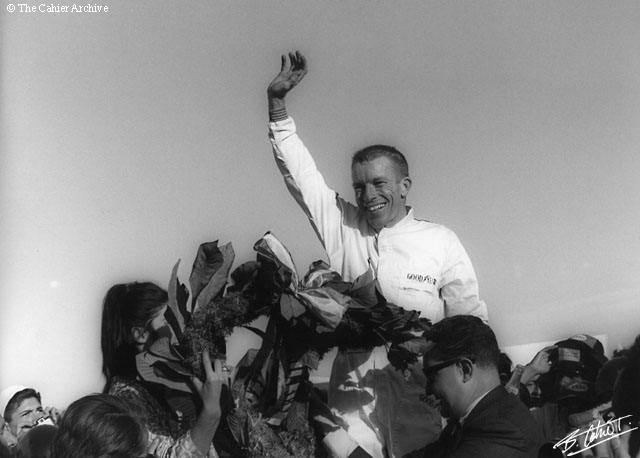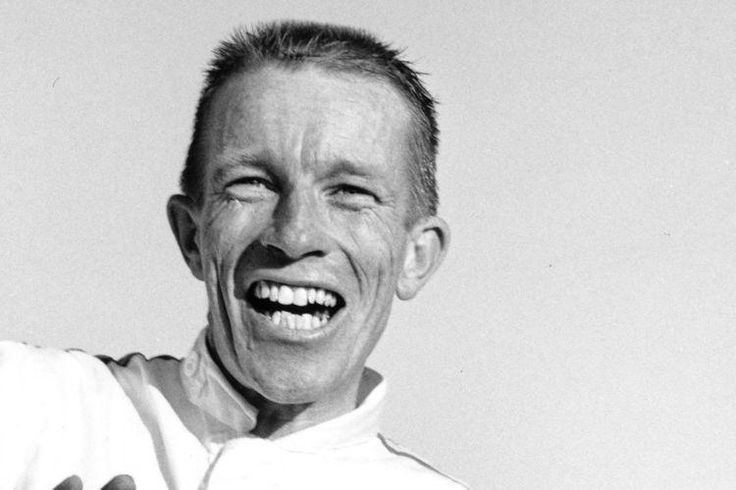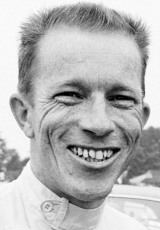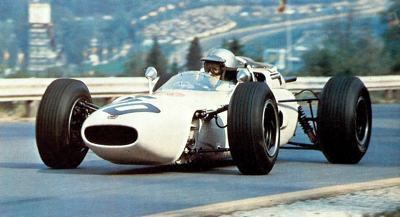Nationality American Wins 1 Active years 1960 – 1967 Name Richie Ginther | Entries 54 (52 starts) Championships 0 | |
 | ||
Born August 5, 1930 ( 1930-08-05 ) Died September 20, 1989, France Similar People John Surtees, Lorenzo Bandini, Chuck Daigh, Jean‑Pierre Beltoise, Lance Reventlow | ||
Dario Franchitti Drives the 1965 Honda RA 272
Paul Richard "Richie" Ginther (Granada Hills, California, August 5, 1930 – September 20, 1989 in France) was a racecar driver from the United States. During a varied career, the 1965 Mexican Grand Prix saw Ginther take Honda's first Grand Prix victory, a victory which would also prove to be Ginther's only win in Formula One. Ginther competed in 54 World Championship Formula One Grand Prix races and numerous other non-Championship F1 events.
Contents
- Dario Franchitti Drives the 1965 Honda RA 272
- Richie ginther and the honda ra272
- Early career
- Ferrari
- BRM and Honda
- Death
- Formula One World Championship results
- Non Championship results
- References

Richie ginther and the honda ra272
Early career

Richie Ginther was raised in the same Californian town as future Formula One World Champion Phil Hill, and it was through Hill, a friend of Ginther's older brother, that Richie Ginther first began to race. After finishing school, in 1948 Richie Ginther followed in his father's footsteps and went to work for Douglas Aircraft, initially in the tool and die shop. In his spare time he helped Phill Hill to repair, maintain and race his collection of old cars and hot rods, as Hill's race career began to gather pace. Ginther made his own race debut at Pebble Beach in 1951, driving a Ford-engined MG T-type sports car.

However, Ginther's own career was put on hold shortly after when he was drafted for two years national service during the Korean War. During this time he received training and experience working in aircraft and engine mechanics, skills which he would later put to good use during his driving career. On emergence from the military Phil Hill requested that Ginther join him, principally as a riding mechanic, in driving a privately entered 4.1-liter Ferrari in the 1953 Carrera Panamericana. The pair ran high in the rankings until Hill lost control, crashed, and wrote off the car. Both Ginther and Hill were unharmed and returned in 1954 to take second place, beaten only by the works Ferrari of Umberto Maglioli.

1954 was also the year that Richie Ginther returned to race driving himself, mostly in a self-prepared Austin-Healey. His results were impressive enough that the following year VW and Porsche dealer John von Neumann hired him to drive a Porsche in domestic competitions. When von Neumann started dealing in Ferrari cars in 1956 Ginther also got the chance to drive these. In between working in von Neumann's Ferrari dealership — including trips to the Ferrari factory in Italy to sort customer problems — Richie Ginther began to build an impressive racing reputation on the West Coast. This and his choice of Ferrari mounts brought him to the attention of the East Coast Ferrari franchise-holder, three-time 24 Hours of Le Mans-winner Luigi Chinetti. Aside from importing Ferrari road cars, Chinetti also operated a successful race team, soon to metamorphose into Ferrari's official motorsport presence in North America: NART. Ginther first raced for Chinetti in 1957 and with him made his first appearances in international level events, first in the 12 Hours of Sebring and then driving a 2-liter Ferrari 500 TR in the 1957 Le Mans race.

Also in 1957, Ginther signed to drive the Aston Martin of Joe Lubin and over the next three years would continue to compete in many sports car racing events in both Aston and Ferrari machinery, with great success. That June he won a 15 lap GT race at the new Lime Rock Park, and won the opening race of the national championship in his Ferrari. In early 1958 he piloted a 2-liter Ferrari to victory at the County Fairgrounds in Pomona, California, averaging 83.8 mph (134.9 km/h), and won in a 3-liter GT in a 5 lap qualifying preliminary for the SCCA Pacific Coast Championship. By the end of the year Ginther had captured the Pacific Coast Sports Car Championship outright. He triumphed by a wide margin at Pomona at the opening sports car race of 1959, in a John von Neumann 4.1-liter Ferrari, and in June 1959 won in a 3-liter Ferrari TR in the first Hourglass road races in San Diego, California. Throughout this period he continued to mix his race driving with a steady job at von Neumann's dealership, and by late 1959 the strain was beginning to show.
Ferrari
Ginther made his F1 debut at the 1960 Monaco Grand Prix driving for Ferrari who he stayed with through 1961. In the September 1960 Italian Grand Prix in Monza he placed second to Phil Hill. Ginther led from the start until the 25th lap when Hill passed him and led until the finish.
Following the 1960 season the Ferrari team gave up 1000 cc in engine size. The 2500 cc engine, permitted the previous year, was replaced by a 1.5-liter rear engine model, with 110 less horsepower. However, the newer engine was superior in both profiling and handling. The conservative Enzo Ferrari was the last major Formula 1 race car manufacturer to make the transition to cars with engines in the rear. In 1961 Ginther was in the #3 Ferrari driver, behind #1 Wolfgang Von Trips and #2 Hill. Giancarlo Baghetti occasionally piloted a fourth car. The team manager was Romulo Tavoni.
On May 14, 1961, Ginther finished 2nd to Stirling Moss at the 1961 Monaco Grand Prix, only 3.6 seconds behind, a few hundred feet. He was driving a new rear-engine Ferrari, a 120-degree V-6 which had a lower center of gravity. Ginther had qualified first, just ahead of Hill, with an average speed of 70.7 mph (113.8 km/h), and a qualifying time of 1:39.3. He eclipsed the previous course record of 1:39.6.
In August 1961 Ginther and Baghetti were teammates at the Pescara Grand Prix, a world auto manufacturers' championship event. Their Ferrari was leading on the 10th lap when it stopped on a straight stretch with a flat tire. Ginther averaged more than 133 mph (214 km/h) on the 6.2-mile (10.0 km) Autodromo Nazionale Monza in September 1961, to lead the first day of qualifying for the 1961 Italian Grand Prix. Von Trips qualified first with Ginther taking the third starting position after Ricardo Rodriguez. Ginther retired in the race. Von Trips died in a spectacular crash on the 2nd lap, which also killed eleven spectators, when his Ferrari climbed a 5-foot-high (1.5 m) earth embankment. It brushed a wire fence employed to restrain a portion of the crowd and struck the spectators. Some who were injured eventually succumbed to number a total of fifteen deaths. The Ferrari team ceased competition until January 1, 1962, as a mark of respect to Von Trips.
BRM and Honda
In the 1962 he switched to the British-based BRM team to race alongside Graham Hill the highlight of which was a second place in the 1963 World Championship behind Hill. He scored more points than his British teammate over the whole season, but only a driver's six best scores were counted towards the championship.
His reputation as a solid "team player" and excellent test and development driver earned him an invitation to join the works Honda F1 team for 1965 for whom he scored his one and only GP win at the 1965 Mexican Grand Prix. The win was also Honda's first in Formula 1. Ginther averaged 151.7 kilometres per hour (94.3 mph) over the curving 5 kilometres (3.1 mi) track in the 65 lap Mexico City event. His speed eclipsed the previous course record of 150.185 km/h (93.321 mph) established by Dan Gurney in 1964. It was also the first time Honda had entered the Mexican Grand Prix. Honda reentered international competition in the 1966 Italian Grand Prix. The team was but three years old and had encountered difficulty in the preparation of a larger engine. Ginther led in Italy before his car crashed into a retaining wall and he broke his collarbone. He signed for the Eagle F1 team in 1967 and raced in the Race of Champions. At Monaco after practice, his place on the grid was given to a F2 car weighted to bring it up to minimum F1 specifications, and Ginther left F1 in disgust.
Ginther won 1 race, achieved 14 podiums, and scored a total of 107 championship points.
He appeared in an uncredited role in the 1966 film Grand Prix as John Hogarth, a driver in the Japanese funded "Yamura" team. He also acted as one of the technical racing advisors for the movie.
While making an attempt to qualify for the 1967 Indy 500, Ginther broke a fuel line in his American Eagle Indy Car. Fuel, a mix of ethanol and gasoline, was sprayed down his back. This experience, along with the memory of being burned earlier, led to his sudden retirement.
He participated in a rally with sixty-five other competitors, including actor James Garner, in June 1969. The California Sports Car Club event was three hours cross country from Los Angeles to Huntington Beach. It benefited students from the Braille Institute. Ginther managed a Porsche 911S with two American drivers during the 39th 24 hours of Le Mans, in June 1971.
Death
Ginther died of a heart attack while on vacation with his family in France on September 20, 1989.
Formula One World Championship results
(key) (Races in italics indicate fastest lap)
Non-Championship results
(key) (Races in bold indicate pole position) (Races in italics indicate fastest lap)
